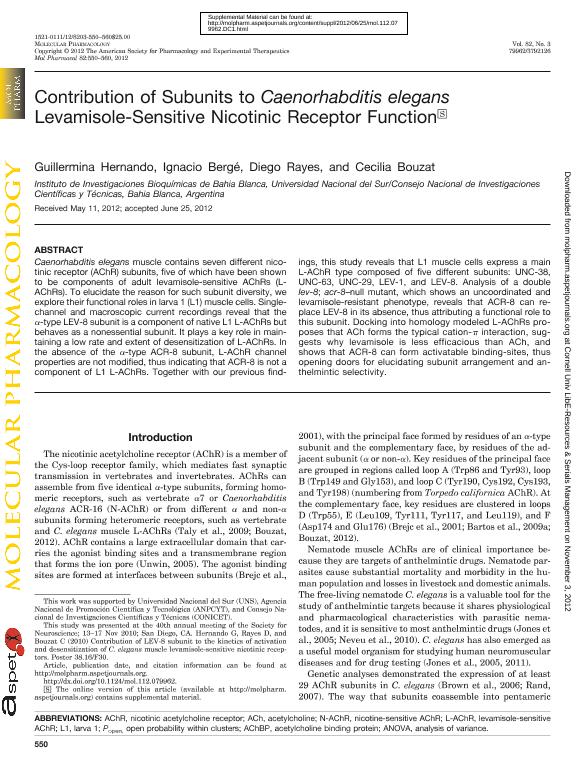Artículo
Contribution of subunits to Caenorhabditis elegans levamisole-sensitive nicotinic receptor function
Fecha de publicación:
25/09/2012
Editorial:
American Society for Pharmacology and Experimental Therapeutics
Revista:
Molecular Pharmacology
ISSN:
0026-895X
e-ISSN:
1521-0111
Idioma:
Inglés
Tipo de recurso:
Artículo publicado
Clasificación temática:
Resumen
Caenorhabditis elegans muscle contains seven different nicotinic receptor (AChR) subunits, five of which have been shown to be components of adult levamisole-sensitive AChRs (L-AChRs). To elucidate the reason for such subunit diversity, we explore their functional roles in larva 1 (L1) muscle cells. Singlechannel and macroscopic current recordings reveal that the α-type LEV-8 subunit is a component of native L1 L-AChRs but behaves as a nonessential subunit. It plays a key role in maintaining a low rate and extent of desensitization of L-AChRs. In the absence of the α-type ACR-8 subunit, L-AChR channel properties are not modified, thus indicating that ACR-8 is not a component of L1 L-AChRs. Together with our previous findings, this study reveals that L1 muscle cells express a main L-AChR type composed of five different subunits: UNC-38, UNC-63, UNC-29, LEV-1, and LEV-8. Analysis of a double lev-8; acr-8-null mutant, which shows an uncoordinated and levamisole-resistant phenotype, reveals that ACR-8 can replace LEV-8 in its absence, thus attributing a functional role to this subunit. Docking into homology modeled L-AChRs proposes that ACh forms the typical cation-π interaction, suggests why levamisole is less efficacious than ACh, and shows that ACR-8 can form activatable binding-sites, thus opening doors for elucidating subunit arrangement and anthelmintic selectivity.
Palabras clave:
C. Elegans
,
Nicotinic Acetylcholine Receptor
,
L-Achr Subunits
Archivos asociados
Licencia
Identificadores
Colecciones
Articulos(INIBIBB)
Articulos de INST.DE INVEST.BIOQUIMICAS BAHIA BLANCA (I)
Articulos de INST.DE INVEST.BIOQUIMICAS BAHIA BLANCA (I)
Citación
Hernando, Guillermina Silvana; Bergé, Ignacio; Rayes, Diego Hernán; Bouzat, Cecilia Beatriz; Contribution of subunits to Caenorhabditis elegans levamisole-sensitive nicotinic receptor function; American Society for Pharmacology and Experimental Therapeutics; Molecular Pharmacology; 82; 3; 25-9-2012; 550-560
Compartir
Altmétricas




